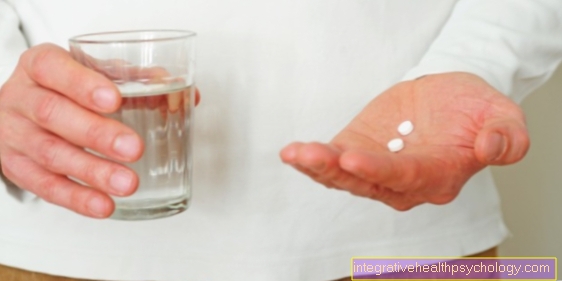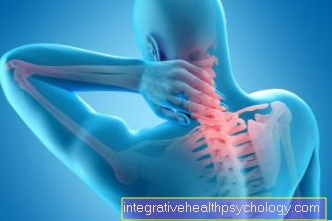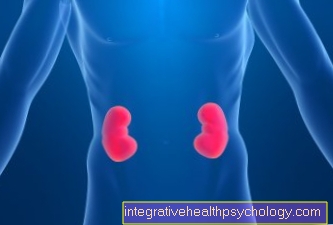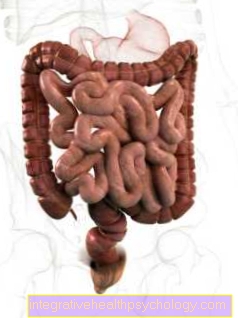Arcoxia®
introduction
Arcoxia® belongs to the group of non-steroidal anti-inflammatory drugs (NSAIDs).
In addition to a good pain-relieving effect, it also has anti-inflammatory effects.

Trade name / manufacturer
Arcoxia® 60 mg
Arcoxia® 90 mg
Arcoxia® 120 mg
by MSD SHARP & DOHME GMBH.
Chemical name
5-chloro-6'-methyl-3- [4- (methylsulfonyl) phenyl] - 2,3'-bipyridine
Active ingredient: Etoricoxib
Areas of application for Arcoxia®
Typical areas of application for Arcoxia® are:
- arthrosis
- Rheumatoid arthritis
- Arthritis in gout
- ankylosing spondylitis
effect
All NSAIDs inhibit an endogenous enzyme, the so-called cyclooxygenase. This enzyme plays a key role in the formation of prostaglandins. A distinction is made between two classes of these Cyclooxygenase (COX-1 and COX-2).
- Pain
- inflammation
- fever
regulate. Prostaglandines also affect blood clotting. Arcoxia® is a member of a relatively new class of anti-inflammatory drugs; it is a selective cyclooxygenase 2 (COX-2) inhibitor. By this one understands, however, only a predominantly the COX-2 inhibiting effect, which is responsible for pain and swelling, while the COX-1, which i.a. Regulated for stomach protection, only slightly inhibit.
In summary, the COX-2 inhibitors are a good approach to treating more selectively, it remains to be seen whether this selective therapy does not lead to an increased risk of side effects (Heart attack and stroke in particular) purchase.
Arcoxia® for headaches
The etoricoxib contained in Arcoxia is similar in its effects to ASA or ibuprofen. A pain-relieving effect can therefore also be expected with headaches. However, due to the possible side effects, Arcoxia is usually not used to treat headaches. In addition, Arcoxia requires a prescription in Germany and is therefore not freely available. In rare cases, Arcoxia can be used in so-called off-label use in combination with triptans against migraines. Triptans are classic remedies for migraines, but their duration of action is relatively short. After the end of the duration of the action of the triptans, migraine symptoms can recur as a recurring headache. Etoricoxib given additionally has a long-term effect and can prevent this.
Arcoxia® for a herniated disc
Like all NSAIDs, Arcoxia also has a pain-relieving effect on a herniated disc. However, it is currently not approved for the treatment of pain in a herniated disc. It also requires a prescription. While pain relief is important in treating a herniated disc, it should be noted that pain has an important natural function. The affected person is forced to take care of their back, which allows the body to heal. It is therefore important not to overload the back even after the treatment.
You might also be interested in this topic: Treatment of a herniated disc
Arcoxia® for osteoarthritis
The etoricoxib contained in Arcoxia is approved in Germany for the treatment of osteoarthritis. It relieves pain and reduces inflammation. Arcoxia seems to be particularly effective against short-term pain attacks. In most cases, even low doses are sufficient. Arcoxia only needs to be taken once a day as its effects last for a relatively long time. Nevertheless, due to the possible side effects, Arcoxia should not be taken over a long period of time if possible. It should be noted that treatment with Arcoxia is primarily symptomatic.
Read more on the topic: Osteoarthritis therapy
Arcoxia® for tendinitis
Arcoxia can also be used to treat tendinitis. The pain-relieving and anti-inflammatory effect of the active ingredient is used here. Most of the time Arcoxia is used as a reserve drug, i.e. used when other drugs are not sufficiently effective. Arcoxia takes effect relatively quickly. However, due to the wide range of possible side effects, Arcoxia is only prescribed very cautiously.
Read more on the topic: Tendinitis
dosage
Arcoxia® is available in doses of 60, 90 and 120 mg.
As an intake recommendation, the manufacturer states that it is taken once a day.
The maximum daily dose is 120 mg per day (however, there are restrictions in the indication and duration, e.g. Attack of gout 120 mg Arcoxia® for a maximum of 8 days).
Arcoxia® 60 mg
Arcoxia® with the active ingredient Etoricoxib is commonly used as a pain reliever. However, there are different dosages for which the respective application areas differ. Arcoxia® 60 means that in one tablet 60 milligrams of the active substance etoricoxib.
This dosage is used primarily to treat the Osteoarthritis pain used.
Osteoarthritis, a bone disease caused by wear and tear, in which the joint cartilage wears more than normal, causes joint pain that can be treated well with Arcoxia® 60. The focus here is on the pain-relieving effect of Arcoxia®.
Arcoxia® 90 mg
Arcoxia® 90 contains 90 milligrams of etoricoxib and thus leaves the treatment greater pain to. Above all, acute pain conditions are an indication for Arcoxia® 90.
This area includes the pain after a Tooth extraction but also inflammatory pain. Inflammatory pain comes with diseases like that rheumatoid arthritis, inflammation of the joints.
90 milligrams of etoricoxib not only relieve pain, but also anti-inflammatory and decongestant on the joints. Another area of application for Arcoxia® 90 is the disease ankylosing spondylitis.
Arcoxia® 120 mg
The highest dosage includes Arcoxia® 120, i.e. 120 milligrams of etoricoxib.
The acute one Attack of gout we are treated with Arcoxia® 120, but the treatment should not last longer than a week, as the drug is excreted via the kidneys and therefore a high level Stress on the kidneys represents.
Furthermore, an increased risk of myocardial infarction and thrombosis was found in many patients after prolonged treatment with active substances from the group of coxibs (e.g. etoricoxib).
Maximum dose of Arcoxia®
The maximum dose of Arcoxia® depends on the cause of the treatment and the underlying diseases:
- When it comes to treating osteoarthritis, no more than 60mg should be taken once a day.
- Rheumatoid arthritis is a maximum dose of 90mg per day.
- In the event of an acute attack of gout, a maximum of 120mg may be taken for eight days.
In all of these diseases, the effect no longer increases from the stated maximum dose for Arcoxia, but the proportion of side effects increases sharply. The maximum dose does not change with age. However, if you have liver disease at the same time, it must be reduced to 60mg per day and further adjusted depending on the severity.
Patients with advanced renal insufficiency or children and adolescents under 16 years of age should not take Arcoxia® at all.
The highest dose that can be sold in Germany is tablets containing 120 mg etoricoxib. This is also the highest recommended daily allowance for Arcoxia. Such a high dose is currently only recommended for the treatment of acute pain in gouty arthritis. In certain cases, for example liver disease, lower maximum doses apply. In general, Arcoxia should be dosed as low and used as briefly as possible. The maximum dose of 120 mg per day should be taken for a maximum of eight consecutive days. This will prevent side effects. In individual studies, doses of up to 500 mg were classified as non-life-threatening, but a doctor should be consulted in the event of an overdose.
Side effects
Side effects on the eyes
Side effects to the eyes are initially expressed in blurred vision. Since Arcoxia® suppresses the inflammatory processes of the body's own immune system, which are responsible for killing harmful pathogens, there are more infections. This side effect on the eyes usually occurs in the form of conjunctivitis (conjunctivitis) and occurs in 1-0.1% of the intake.
Arcoxia® fatigue
As a further side effect when taking Arcoxia®, fatigue can occur in 1-10% of the applications. In many cases the tiredness is accompanied by headaches and dizziness. However, it can also arise from the sleep disturbances that occasionally occur when taking Arcoxia. Fatigue is a common side effect of Arcoxia. A side effect classified as “common” (occurs in 1-10% of patients treated). Often there is also a feeling of weakness. Flu-like symptoms can also arise. This may be due to Arcoxia acting on the central nervous system. However, this has not yet been finally investigated.
Arcoxia® and alcohol - are they compatible?
Caution is advised when taking Arcoxia® and alcohol at the same time. Arcoxia® inhibits the enzyme cyclooxygenase 2 (COX2). Like the enzyme COX1, which is only slightly different in structure, it is responsible for forming certain enzymes, the prostaglandins. These ensure the proper structure of the gastric mucosa.
Due to the inhibition of the cyclooxygenases, the gastric mucosa is no longer built up properly, making the stomach more unprotected and more easily attacked. Although COX1 is increasingly present in the stomach area, the effect of the inhibition of COX2 by Arcoxia is sufficient to influence the gastric mucosa. If this is weakened, the stomach is more strongly attacked by the acidity of the alcohol and it can lead to nausea or even stomach bleeding. For this reason, taking Arcoxia for a long time in particular is not compatible with alcohol.
High blood pressure when taking Arcoxia®
The enzyme (COX2), which is inhibited by Arcoxia®, is, among other things, increasingly present in the kidneys. The kidneys are responsible for regulating the body's fluid volume and reducing blood pressure by excreting water. The prostaglandins, which are formed by the COX2, are very important for the blood flow to the kidneys and their function, especially if the kidney function is already impaired. Therefore, by taking Arcoxia® and inhibiting COX2, the kidneys can continue to lose function and excrete less water. As a result, the blood pressure rises as a side effect of Arcoxia® in 1-10% of the applications. Furthermore, the effect of some antihypertensive drugs can be weakened by Arcoxia®.
Other side effects
The side effects that can occur when taking Arcoxia® include:
- Allergic reaction:
- Rash (redness, itching)
- Drop in blood pressure
- shock
- Gastrointestinal complaints
- Inflammation of the stomach lining
- Water retention in the tissue (edema)
- Tinnitus
- a headache
- Psychological complaints:
- sleepiness
- Poor concentration
- depression
- Laboratory changes (laboratory values)
- Increase in liver enzymes in the blood
- Decrease in red blood cells
- Cardiovascular problems
- Palpitations
- high blood pressure
Since each person reacts individually to medication, side effects can of course also occur that are not mentioned here.
Read more on this topic at: Side effects of Arcoxia®
Side effects after discontinuation

Arcoxia® is mainly used for Treatment of pain. If the medication with Arcoxia® is discontinued, the pain can recur. Many patients then become more aware of this pain. Arcoxia® can usually be discontinued without a dose reduction. Most of the side effects experienced with the medication go away on their own after stopping the medication. Only the decrease in body weight can drag on. How quickly you lose the weight again depends on your own eating habits and physical activity.
Note
Arcoxia® belongs to the group of new COX-2 inhibitors, also to the group to which Vioxx belonged, a drug that was withdrawn from the market on September 30, 2004 due to side effects in the cardiovascular area. Such side effects are currently for Arcoxia® not known to this extent.
interaction
Anticoagulants
Arcoxia® should not be used at the same time as anticoagulant preparations or preparations of the same class of active ingredients (e.g. Diclofenac / Indomethacin / Piroxicam / Ibuprofen) are given.
Especially with the simultaneous administration of Marcumar® should be taken into account, the blood-thinning effect of Marcumar® reinforced.
The effect of antihypertensive drugs (ACE inhibitors, Beta blockers, D.iuretics) can be weakened.
Interaction with the pill
Arcoxia shows interactions with the birth control pill. Since Arcoxia affects several enzymes in the liver metabolism, the contraceptive effect of the pill may be weakened. Another interaction is even more important: both Arcoxia and the pill increase the risk of thrombosis. Taking both drugs at the same time is therefore potentially dangerous. This is especially true if there are other risk factors such as smoking, obesity or immobilization.
Arcoxia® and alcohol
Taking medication and alcohol at the same time is a problematic issue. Alcohol strengthens or weakens most drugs in their effect.
Long-term use of Arcoxia® increases this Risk of stomach ulcers. These ulcers can potentially cause life-threatening gastrointestinal bleeding. This bleeding can be massively increased by the regular consumption of alcohol, as it has blood-thinning properties. also increases more regular Alcohol consumption especially in combination with other risk factors such as obesity or smoking, the risk of heart attack or thrombosis.
Cardiovascular diseases are also serious side effects while taking Arcoxia®. The risk of such a disease increases significantly through alcohol consumption while taking Arcoxia®.
Alcohol not only stresses the heart and circulation, but also your liverbecause it metabolizes alcohol. In some cases Arcoxia® also causes liver damage or restricts liver function. Again, if you take alcohol and Arcoxia® at the same time, a Double burden for the body. So it is recommended during the Therapy with Arcoxia® or similar drugs as far as possible Refrain from alcohol.
Alternatives
Since Arcoxia has several areas of application, there are correspondingly many alternatives. In a specific case, it is therefore worth talking to the doctor treating you about the alternatives. The analgesic and anti-inflammatory effects are also shown by other NSAIDs to a very similar extent. These include, for example, ASA, ibuprofen or diclofenac. A change can therefore be worthwhile, especially if you have intolerance. There are also physical or even surgical therapies for diseases such as rheumatoid arthritis or arthrosis. Both can of course also be combined with Arcoxia.
Read more on the topic: NSAIDs
Contraindications
You mustn't Arcoxia® take if you:
- are or become pregnant (it is better to use alternatives such as Paracetamol)
- breastfeeding
- have already had an allergic reaction to one of the components of Arcoxia®
- already allergic to a drug from the drug group "Sulfonamides"(Are among others as Antibiotics used in cystitis) have reacted.
- after taking aspirin® or other non-steroidal anti-inflammatory agents (NSAIDs) like for example Ibuprofen allergic reactions such as skin rashes, swelling, itching, or shortness of breath have occurred
- suffer from inflammatory bowel disease (e.g. Crohn's disease)
- a Gastric ulcer and / or have a duodenal ulcer (ulcer)
- severe disorders from liver and kidney to have
- a very difficult one Heart failure (decompensated heart failure)
Arcoxia® use during pregnancy
During one pregnancy medication should always be carefully considered. Many active substances can harm the unborn child. Arcoxia® should be used during pregnancy not taken because the drug inhibits the body's production of substances which, among other things, maintain the oxygen supply to the child in the womb. Even during the Lactation becomes an intake of Arcoxia® not recommended.





























